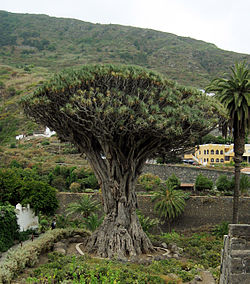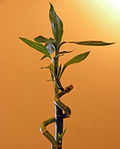Dracaena (plant)
| Dracaena Temporal range: Oligocene-Recent[1]
| |
|---|---|

| |
| Dracaena draco in Icod de los Vinos | |
| Scientific classification | |
| Kingdom: | Plantae |
| Clade: | Tracheophytes |
| Clade: | Angiosperms |
| Clade: | Monocots |
| Order: | Asparagales |
| Family: | Asparagaceae |
| Subfamily: | Convallarioideae |
| Genus: | Dracaena Vand. ex L.[2] |
| Diversity | |
| 200–220 species | |
| Synonyms[2][3] | |
| |
Dracaena is a genus of about 200–220 species of trees and succulent shrubs.[2] The formerly accepted genera Pleomele and Sansevieria are now included in Dracaena.[2][4] In the APG IV classification system, it is placed in the family Asparagaceae,[5] subfamily Convallarioideae (formerly the family Ruscaceae).[6][7] It has also formerly been separated (sometimes with Cordyline) into the family Dracaenaceae or kept in the Agavaceae (now Agavoideae).
The name dracaena is derived from the Latinised form of the Ancient Greek δράκαινα – drakaina, "female dragon".[8]
The Plants of the World Online database accepts 214 species as of September 2025[update].[2] The majority of the species are native to Africa (including the Canary Islands and Socotra), southern Asia, and northern Australia, but also seven species in Hawai'i, and two in tropical Central America.[2]
Description
[edit]Dracaena species can have two growth types: arborescent (tree- or shrub-like) dracaenas (e.g. Dracaena cinnabari, Dracaena draco, Dracaena fragrans), which have stout above-ground stems to around 20 metres tall that branch from nodes after flowering, or if the growth tip is severed; and rhizomatous dracaenas (e.g. Dracaena trifasciata, Dracaena angolensis), which have underground rhizomes and leaves on the surface, ranging from straplike to cylindrical.[4][9]
The arborescent species of Dracaena have a secondary thickening meristem in their trunks,[10][11] termed Dracaenoid thickening by some authors,[12] which is quite different from the thickening meristem found in dicotyledonous plants. This characteristic is shared with some members of the Agavoideae, Lomandroideae, and Xanthorrhoeoideae among other members of the Asparagales.[10]
Many species of Dracaena are kept as houseplants due to tolerance of low light and sparse watering.[13]
Selected species
[edit]- Dracaena aethiopica (Thunb.) Byng & Christenh.
- Dracaena afromontana Mildbr.
- Dracaena aletriformis (Haw.) Bos (syn. D. latifolia)
- Dracaena americana Donn.Sm. – Central America dragon tree
- Dracaena angolensis (Welw. ex Carrière) Byng & Christenh.
- Dracaena angustifolia (Medik.) Roxb.
- Dracaena arborea (Willd.) Link
- Dracaena arborescens (Cornu ex Gérôme & Labroy) Byng & Christenh.
- Dracaena aubrytiana (Carrière) Byng & Christenh.
- Dracaena aurea H.Mann
- Dracaena bagamoyensis (N.E.Br.) Byng & Christenh.
- Dracaena ballyi (L.E.Newton) Byng & Christenh.
- Dracaena braunii Engl. (syn. D. litoralis)
- Dracaena cinnabari Balf.f. – Socotra dragon tree
- Dracaena cochinchinensis (Lour.) S.C.Chen (syn. D. loureiroi)
- Dracaena draco (L.) L. – Canary Islands dragon tree
- Dracaena eilensis (Chahin.) Byng & Christenh.
- Dracaena ellenbeckiana Engl. - Kedong Dracaena (Ethiopia, Kenya, Uganda)[14][15]
- Dracaena elliptica Thunb. & Dalm.
- Dracaena fernaldii (H.St.John) Jankalski
- Dracaena forbesii (O.Deg.) Jankalski
- Dracaena fragrans (L.) Ker Gawl. (syn. D. deremensis) – striped dracaena, compact dracaena, corn plant, cornstalk dracaena
- Dracaena ghiesbreghtii W.Bull ex J.J.Blandy
- Dracaena goldieana Bullen ex Mast. & T.Moore
- Dracaena halapepe (H.St.John) Jankalski
- Dracaena hallii (Chahin.) Byng & Christenh.
- Dracaena hanningtonii Baker (syn. D. oldupai)
- Dracaena jayniana Wilkin & Suksathan
- Dracaena kaweesakii Wilkin & Suksathan[16]
- Dracaena konaensis (H.St.John) Jankalski
- Dracaena malawiana Byng & Christenh.
- Dracaena mannii Baker
- Dracaena masoniana (Chahin.) Byng & Christenh.
- Dracaena ombet Heuglin ex Kotschy & Peyr. – Gabal Elba dragon tree
- Dracaena ovata Ker Gawl.
- Dracaena pearsonii (N.E.Br.) Byng & Christenh.
- Dracaena pethera Byng & Christenh.
- Dracaena pinguicula (P.R.O.Bally) Byng & Christenh.
- Dracaena reflexa Lam. – Pleomele dracaena or "Song of India"
- D. reflexa var. marginata (syn. D. marginata) – red-edged dracaena or Madagascar dragon tree
- Dracaena rockii (H.St.John) Jankalski
- Dracaena sanderiana Engl. – ribbon dracaena, marketed as "lucky bamboo"
- Dracaena serrulata Baker – Yemen dragon tree
- Dracaena singularis (N.E.Br.) Byng & Christenh.
- Dracaena spathulata Byng & Christenh.
- Dracaena steudneri Engl.
- Dracaena stuckyi (God.-Leb.) Byng & Christenh.
- Dracaena suffruticosa (N.E.Br.) Byng & Christenh.
- Dracaena surculosa Lindl. – spotted or gold dust dracaena. Formerly D. godseffiana
- Dracaena tamaranae Marrero Rodr., R.S.Almeira & M.Gonzáles-Martin
- Dracaena transvaalensis Baker
- Dracaena trifasciata (Prain) Mabb.
- Dracaena umbraculifera Jacq.
- Dracaena viridiflora Engl. & K.Krause
- Dracaena zeylanica (L.) Mabb.
Formerly regarded as Dracaena
[edit]This section needs to be updated. (June 2017) |
- Asparagus asparagoides (L.) Druce (as D. medeoloides L.f.)
- Cordyline australis (G.Forst.) Endl. (as D. australis G.Forst.)
- Cordyline fruticosa (L.) A.Chev. (as D. terminalis Lam.)
- Cordyline indivisa (G.Forst.) Steud. (as D. indivisa G.Forst.)
- Cordyline obtecta (Graham) Baker (as D. obtecta Graham)
- Cordyline stricta (Sims) Endl. (as D. stricta Sims)
- Dianella ensifolia (L.) DC. (as D. ensifolia L.)
- Liriope graminifolia (L.) Baker (as D. graminifolia L.)
- Lomandra filiformis (Thunb.) Britten (as D. filiformis Thunb.)[17]
Uses
[edit]Ornamental
[edit]Some shrubby species, such as D. fragrans, D. surculosa, D. marginata, and D. sanderiana, are popular as houseplants. Many of these are toxic to pets, though not humans, according to the ASPCA among others. Rooted stem cuttings of D. sanderiana are sold as "lucky bamboo", although only superficially resembling true bamboos.
Dracaena houseplants like humidity and moderate watering. They can tolerate periods of drought but the tips of the leaves may turn brown.[18] Leaves at the base will naturally yellow and drop off, leaving growth at the top and a bare stem.[18] Dracaena are vulnerable to mealybugs and scale insects.[18]
Other
[edit]A naturally occurring bright red resin, dragon's blood, is collected from D. draco and, in ancient times, from D. cinnabari. Modern dragon's blood is, however, more likely to be from the unrelated Calamus rattan palms, formerly placed in Daemonorops.[a] It also has social functions in marking graves, sacred sites, and farm plots in many African societies.[20]
Gallery
[edit]-
Dracaena tamaranae - native to Gran Canaria
References
[edit]Notes
[edit]Citations
[edit]- ^ Denk; et al. (2014). "From mesic to arid: Leaf epidermal features suggest preadaptation in Miocene dragon trees (Dracaena)". Review of Palaeobotany and Palynology. 200: 211–228. Bibcode:2014RPaPa.200..211D. doi:10.1016/J.REVPALBO.2013.09.009.
- ^ a b c d e f "Dracaena Vand. ex L." Plants of the World Online. Royal Botanic Gardens, Kew. Retrieved 2025-07-05.
- ^ "Genus: Dracaena Vand. ex L." Germplasm Resources Information Network. United States Department of Agriculture. 2010-01-19. Archived from the original on 2010-05-30. Retrieved 2011-02-07.
- ^ a b Lu, Pei-Luen; Morden, Clifford W. (2014-03-01). "Phylogenetic Relationships among Dracaenoid Genera (Asparagaceae: Nolinoideae) Inferred from Chloroplast DNA Loci". Systematic Botany. 39 (1): 90–104. doi:10.1600/036364414X678035. Retrieved 2025-09-01.
- ^ Coombes 2012, p. 127.
- ^ Chase, Reveal & Fay 2009, pp. 132–136.
- ^ Angiosperm Phylogeny Group 2016, pp. 1–20.
- ^ Merriam-Webster Dictionary
- ^ Huxley, Anthony (1992). Royal Horticultural Society Dictionary of Gardening. Vol. 2. London : New York: Macmillan Press. pp. 96–97. ISBN 1-56159-001-0.
- ^ a b Rudall, Paula (1991). "Lateral Meristems and Stem Thickening Growth in Monocotyledons". Botanical Review. 57 (2). New York Botanical Garden Press: 150–163. ISSN 0006-8101. JSTOR 4354165. Retrieved 2025-09-01.
- ^ Marcinkiewicz, Jan; Jura-Morawiec, Joanna (2024-03-12). "New insight into secondary growth in roots of monocotyledons using the example of the dragon tree, Dracaena draco L.". Brazilian Journal of Botany. 47 (2): 399–404. doi:10.1007/s40415-024-00997-x. ISSN 1806-9959. Retrieved 2025-09-01.
- ^ "Dracaenaceae". The Dragon's Blood Tree Page. Retrieved 2025-09-01.
- ^ Wong, James (2021-05-09). "Fancy a plant that will grow old with you?". The Guardian. Retrieved 2021-08-10.
- ^ "Dracaena ellenbeckiana". World Checklist of Selected Plant Families (WCSP). Royal Botanic Gardens, Kew.
- ^ "Dracaena ellenbeckiana (Kedong Dracaena)". exoten-garten.de.tl (in German). 2009. Retrieved 30 Jan 2016.
- ^ Wilkin et al. 2013, pp. 101–112.
- ^ "Dracaena names". Multilingual Multiscript Plant Name Database. Retrieved 23 September 2020.
- ^ a b c Peerless, Veronica (2017). How Not to Kill Your Houseplant. DK Penguin Random House. pp. 68–69.
- ^ Sunderland & Dransfield 2002.
- ^ Sheridan 2008, pp. 491–521.
Sources
[edit]- Angiosperm Phylogeny Group (2016). "An update of the Angiosperm Phylogeny Group classification for the orders and families of flowering plants: APG IV". Botanical Journal of the Linnean Society. 181 (1): 1–20. doi:10.1111/boj.12385.
- Chase, M.W.; Reveal, J.L. & Fay, M.F. (2009). "A subfamilial classification for the expanded asparagalean families Amaryllidaceae, Asparagaceae and Xanthorrhoeaceae". Botanical Journal of the Linnean Society. 161 (2): 132–136. doi:10.1111/j.1095-8339.2009.00999.x.
- Coombes, Allen J. (2012). The A to Z of Plant Names: A Quick Reference Guide to 4000 Garden Plants. Timber Press. ISBN 978-1-60469-196-2.
- Sunderland, Terry C.H.; Dransfield, John (2002). Florentino O.; Dransfield, John; Tesoro; N. Manokaran (eds.). "Species Profiles Rattans". Rattan, Current Research Issues and Prospects for Conservation and Sustainable Development. 14: 23–34.
- Sheridan, M. (2008). "Tanzanian ritual perimetrics and African landscapes: the case of Dracaena". International Journal of African Historical Studies. 41 (3): 491–521. JSTOR 40282529.
- Wilkin, Paul; Suksathan, Piyakaset; Keeratikiat, Kaweesak; van Welzen, Peter; Wiland-Szymanska, Justyna (2013). "A new species from Thailand and Burma, Dracaena kaweesakii Wilkin & Suksathan (Asparagaceae subfamily Convallarioideae)". PhytoKeys (26): 101–112. Bibcode:2013PhytK..26..101W. doi:10.3897/phytokeys.26.5335. PMC 3817424. PMID 24194672.
Further reading
[edit]- Waterhouse, J. T. (1987). "The phylogenetic significance of Dracaena-type growth". Proceedings of the Linnean Society of New South Wales. 109: 129–138.
External links
[edit] Media related to Dracaena at Wikimedia Commons
Media related to Dracaena at Wikimedia Commons Data related to Dracaena at Wikispecies
Data related to Dracaena at Wikispecies- Socotra botany Archived 2011-06-11 at the Wayback Machine. Royal Botanic Garden, Edinburgh.









